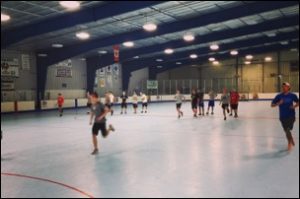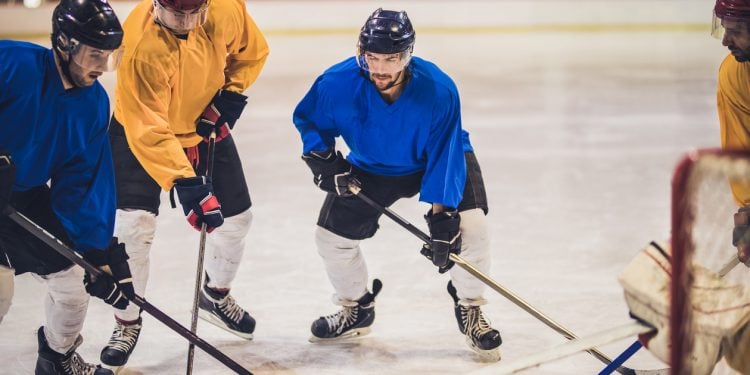Avoiding non-contact injuries with corrective exercise can help keep your hockey team on the ice and in the game.
Any time I mention that I am a hockey player, the first question I get is, “How come you still have all of your teeth?” Hockey is understood to have an incredibly high risk for injury. Vulcanized rubber flying at 100 mph, blades cutting through ice, and bodies crashing into glass can’t be healthy.
However, these accepted aspects of the game are contact-related and not the only reasons the team may have some players on the injured reserve list. There are many musculoskeletal issues that can lead to reoccurring injuries, all of which can be avoided with the proper training techniques.
If training hockey players sounds like a great career, consider learning more about what it takes to become a strength and conditioning coach by following the link.
A breakdown of hockey
Hockey teams in most leagues are comprised of 23 players, 20 of which need to be healthy enough to skate on game day. Although every player has individual needs, there are many commonalities to the muscular imbalances incurred when playing hockey. (Note: This article will still be useful for goalies, however they have very specific needs that will be addressed in a future article).
 Training drills at goalie camp.
Training drills at goalie camp.
Your body is a series of levers with muscles attached on each side, sometimes across multiple joints. When these muscles are not at their optimal lengths, it does not allow for the musculoskeletal system to move properly. Not only can this lead to injuries, but it can also keep your athletes from performing at their very best. As a strength and conditioning coach in the United States Hockey League (USHL), I like to use the Overhead Squat Assessment (OHSA) when evaluating players for such imbalances. This method is incredibly accurate and efficient when used correctly.
As previously mentioned, ice hockey is very unique in the demand on its players. A typical skating motion is multiplanar in nature, involving both the frontal and sagittal planes with the legs. As the game is spent predominately skating forward, this motion involves your hips, knees, and ankles moving away from your spine. Skaters are also always taught to keep their stick on the ice, however most players don’t pay attention to posture when doing so. This creates a forward roll in the shoulders and upper back. Considering these motions, here are some of the most common issues (and corresponding solutions) found by using the OHSA for the many hockey players I’ve worked with:
Feet Turn Out:
- The probable overactive muscles are the soleus, lateral gastrocnemius, bicep femoris (short head), and tensor fascia latae.
- The probable underactive muscles are the medial gastrocnemius, medial hamstring, gluteus medius/maximus, gracilis, and popliteus.
Knees Turn Out:
- The probable overactive muscles are the piriformis, biceps femoris, tensor fascia latae, and gluteus minimus/medius.
- The probable underactive muscles are the adductor complex, medial hamstring, and gluteus maximus.
Arms Fall Forward:
- The probable overactive muscles are the latissimus dorsi, pectoralis major/minor, teres major, and coracobrachialis.
- The probable underactive muscles are the mid/lower trapezius, rhomboids, rotator cuff, and posterior deltoid.
Now, what does this mean? Simply put, the overactive muscles need to be lengthened while the underactive muscles need to be strengthened. There are four steps to the NASM Corrective Exercise Continuum when correcting these issues.
- Inhibit: Self-myofascial release (SMR), such as foam rolling, is a great way to inhibit the overactive muscles to aide in the lengthening process.
- Lengthening: Static stretching, active-isolated stretching, dynamic stretching, and neuromuscular stretching are all examples of different ways to lengthen the overactive muscle.
- Activate: Strengthening the under active muscles must be done in a controlled fashion, focusing on the muscle contracting through the full range of motion.
- Integrate: Now that the tighter muscles are lengthened and the weaker muscles are activated, the integration step allows for the athlete to move properly through a motion that involves the entire body.
As any hockey player knows, there is a lot of time spent on the ice both in- and off-season. It is important to be sure that these corrective workouts are consistent and well timed. I place specific corrective workouts as “recovery workouts” after a weekend of games. This allows for each player to undo the damage done while on the ice to keep the body moving properly for optimal performance. The rest of the week can be spent on stability, flexibility, strength, and power.
Hockey is a very demanding game with a high risk for injury. Bumps, bruises, and teeth may come and go throughout the season. (But hey, that’s where ice and great smoothie recipes help). Following the guidelines for corrective exercise and properly timing workouts can help athletes stay healthy and in game shape all year. That is what kept me injury free since the start of my hockey career. As for the answer to why I still have all of my teeth - I’m a goalie.
Sources
Clark, M. A., Lucett, S. C., & Sutton, B. G. (Eds.). (2014). NASM Essentials of Corrective Exercise Training. Burlington, MA: Jones & Barlett Learning.
NASM (2018). NASM Essentials of Personal Fitness Training (6th ed.). Burlington, MA: Jones & Barlett Learning.











